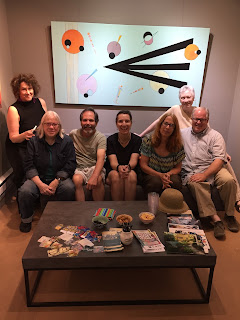At a recent opening of my show in Rochester, one relatively sophisticated viewer pointed out that some of the paintings looked like they were by different people. The organic, textured, flowing, hot colored abstract landscape next to three muted, resin coated circles and dots bothered him.
 |
| Tenerife. 36x72 |
 |
| Specimens 30x30 |
Not me, though. Having come to painting late, I insisted on spending a few years going through many stages of representational rendering- flowers, fish, fruit, figures- and that’s just the ‘f’s- to prove to myself that I could. When I decided I had captured clouds and sunrises and the sea, I got rid of the horizon line- and I was painting abstractly, which had been my goal all along.
Rather than experiment in style pastiche or stages I think I paint in paragraphs. A new idea emerges, it gets done again, different iterations, then I revisit what I had thought was finished. When this essay is finished, I move on. Mark Rothko and Vassilly Kandinsky both started with
small paintings that all looked like Chagall villages. Once they reached their abstract voices, and the collectors responded, their dealers took all the early work off the market. Rothko’s early paintings now line the walls of his son Christopher Rothko on the Upper West Side.
But an even more important question might be why do we do in the times in which we live. I wrestle with this as a painter but also as a person who does not respond to didactic art. But art for art’s sake has its own power, both for the maker and for the viewer.
The painting I’ve called Remains of the Day should indeed be taken as a warning, with the suggestion of a mushroom cloud masquerading as a tree hovering over a midwestern town. But it’s also a play on line, on the muted color of ink soaking into unprimed canvas. Cascadilla was named after the fact, because of what looks like a waterfall and an arched bridge and walls of shale- but I painted it as a play of shapes and texture. The suggestion of Tuscan hill towns among the imaginary landscapes is due to a few horizontal lines that turn inchoate color into landscapes.
 |
| Remains of the Day |
 |
| Cascadilla |
 |
| Tuscan Hills |
My most recent work, which I'll be expanding into a novella, is probably the best example of looking like it was done by a different person. But of course, the rigor of hard edged rendering is the same skill I used in doing watercolor flowers or oil still lives. The colors are my favorites throughout all my work, blues and reds and pinks, just covering bigger and more discrete areas.
But why go from free and flowing abstracts to these? It's the anniversary of the moon walk, which is certainly at the tail end of the last midcentury, but I hadn't thought of that. I was looking at some old futuristic world's fair pictures, and saw that the Jetsons cartoon show was only on for a year, that could have been the inspiration. I have a book on Kandinsky from 20 years ago that I looked at AFTER I had done three of these paintings, and realized how similar they were.
But most of all, the process of doing these is one way to control chaos, to contain the political outrages that color my world view from the minute I wake up until I go to sleep. I can't change the broader picture by myself, but I CAN control the canvas in front of me, and emerge with an interplay of shapes and colors that make me feel calm, and that viewers respond to.
I bring my own thoughts or feelings to the paintings, but viewers see things I never thought of, or intended- which is why I do this, now.










Comments